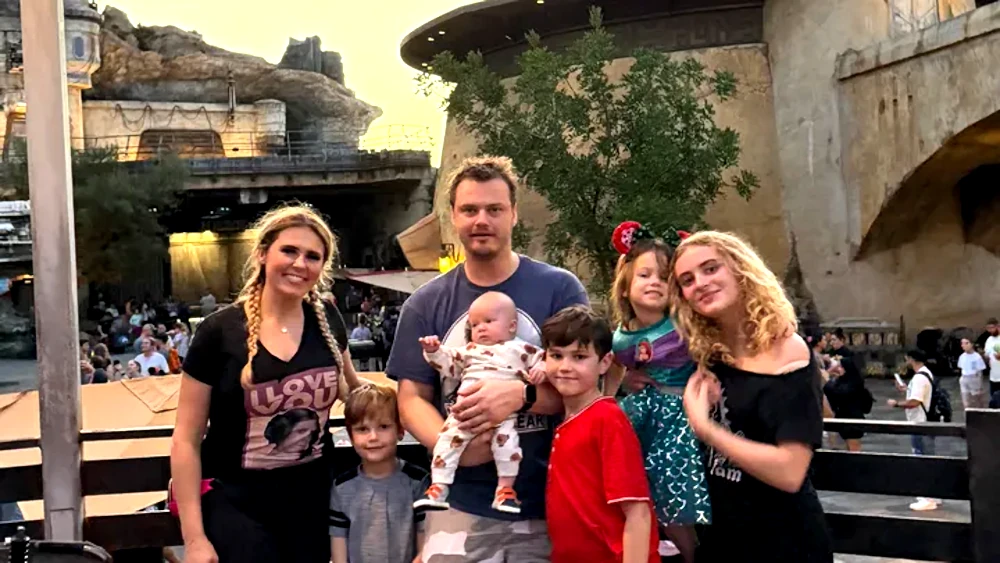
To give, visit https://www.gofundme.com/f/RyanandKel
By Mike Weland
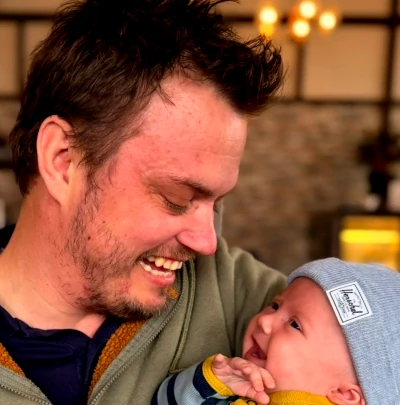
I don’t know if it’s common among young humans first trying to grasp the concept of numbers to set about counting to the last and highest number that is, not quite realizing how vast the scope of that endeavor. I think I counted to about 300, going just as fast as I could, before realizing how futile the effort and losing interest in mathematics.
Ryan Becker is quite possibly the healthiest man alive to stretch the odds to astronomical proportions by acquiring the rare condition that now threatens to kill him. He counts himself blessed.
There are an estimated 8.2-billion people walking the face of Earth today. Since the dawn of mankind, about 117-billion people have seen a sunrise. In Arabic numerals that’s 117,000,000,000. It’s CXXVII,MMMMMMMMMMMMMMMMMMMM in Roman numerals and 1101111011100001000000000000 in binary, the language of computers. No matter how you look at it, it’s a big number.
Mikkel and Ryan Becker, two of an estimated 340.1-million (340,100,000) current citizens of the United States, were wed July 22, 2024, and on November 3, they welcomed into the world son Atlas. All three were happy, healthy and wholly unaware of the impending exponential numbers they would soon attempt to grasp for understanding, nor for the hostility they’d face before they found a physician undaunted by long odds.
In February, 2025, Ryan, 37, began breaking out in terribly painful lesions that soon covered 30-percent of his external skin surface and internally in his mouth and nose. Batteries of tests in a Spokane hospital brought no answers, only infuriating assertions that he’d brought the malady down upon himself, scratching at imaginary itches at best, drawing incredulous rage at the worst allegations.
A career emergency medical technician with a Spokane fire department, Ryan had nightmares of being first responder on scenes of things now being insinuated as cause of his calamity. Being called to an elderly man in cardiac arrest only find three infants lying side by side on a ratty bed, three days dead, left behind by foster parents fleeing criminal charges for supplementing their babysitting income cooking the meth that choked the life out of the wards entrusted to them.
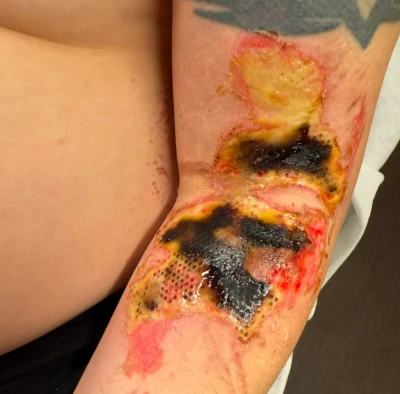 To be so suspected, to be told by physicians to stop scratching, that it was most likely psychosomatic, all in his head, was both hurtful and infuriating and both Ryan and Kel went through a period of anger. What soon dawned on Ryan was that he never heard his wife say “why me?”
To be so suspected, to be told by physicians to stop scratching, that it was most likely psychosomatic, all in his head, was both hurtful and infuriating and both Ryan and Kel went through a period of anger. What soon dawned on Ryan was that he never heard his wife say “why me?”
“She truly and honestly saved us,” Ryan said. “Hope wanes, and it was rough.”
A common response from those first hearing of Ryan’s plight is the likening of terrible pain he’s experienced with the tribulation of Job.
“There are similarities, but I’m no Job,” Ryan said, laughing.
Before he was tested with boils, the blameless and upright Job lost his friends, his wealth, his children, his wife.
“I haven’t lost anything,” Ryan said. “Kel never expressed a doubt, Atlas still looks to me when he wants to play. I am blessed.”
When physicians in Spokane were unable to determine a cause, they travelled to the Mayo Clinic, Rochester, Minnesota, and again, the condition left dermatologists baffled. On February 28, Ryan was referred to John Hopkins Sibley Memorial Hospital in Washington D.C. and the National Institutes of Health’s Undiagnosed Diseases Program.
Ryan and Kel at last learned the name of the monster so aggressively tormenting Ryan as the diagnosis, Pyoderma Gangrenosum, is as enigmatic as the disease itself.
“Pyoderma gangrenosum (PG) is a rare, chronic skin condition characterized by painful, deep ulcers that typically develop on the legs.”
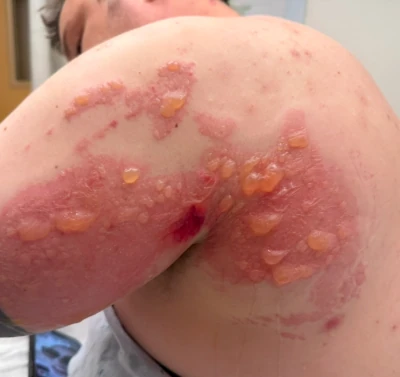 Cause — unknown. Diagnosis — based on clinical appearance after all other skin conditions of similar appearance are ruled out. There is no cure. About the sole good news is that it’s not contagious.
Cause — unknown. Diagnosis — based on clinical appearance after all other skin conditions of similar appearance are ruled out. There is no cure. About the sole good news is that it’s not contagious.
And the numbers are daunting. Each year, approximately 10 people in a million, about 80,000 world wide, contract the most prevalent of three subvariants, about .001-percent of the global population.
There are three main subvariants of Pyoderma gangrenosum; ulcerative, bullous and pustular, based on the form of the lesions.
For about half of those diagnosed, no underlying cause can be determined, nor do they have any of the underlying conditions known to trigger PG, they are idiopathic.
Fewer than 100 of the idiopathic patients worldwide, about 0.25-percent, present two subvariants each year. Only one idiopathic PG patient has presented with all three … in history.
The odds that any human to ever walk upon this earth would share the condition Ryan is facing now is one in 17,500,000,000,000 … 17.5 trillion. The odds of the condition hitting one person in any given year is an estimated one in 1.67 quintillion — 1,670,000,000,000,000,000.
There are 14 doctors nationwide who specialize in Pyoderma gangrenosum and the president of their fellowship is Dr. Alex Ortega-Loayza. associate professor of dermatology at Oregon Health and Science University, Portland, where his research focuses on advancing diagnostic tools and treatment for the rare and often misdiagnosed condition of pyoderma gangrenosum.
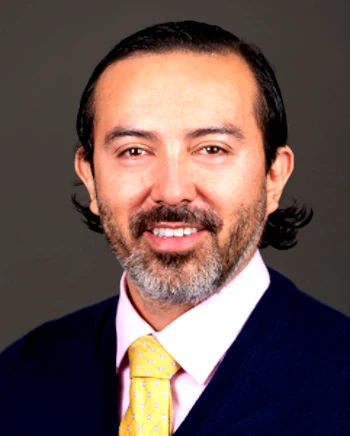
At OHSU, he has assembled a team of basic scientists, biostatisticians, and clinicians to form the pyoderma gangrenosum study team (PYGAS).
The family crossed the nation again, to Portland and a meeting with Dr. Ortega.
“Leaving our hotel room yesterday morning felt heavier than ever,” Kel posted March 20. “As we walked out hand-in-hand toward Ryan’s appointment with Dr. Ortega at OHSU, I couldn’t help but pause and imagine a world without him. I tried—but the thought was unimaginable.”
Ryan’s condition had deteriorated while at John’s Hopkins. More lesions, more pain, and more uncertainty. Dr. Ortega represented their last hope.
They left with the diagnosis, to include all the worst aspects confirmed, but no high hopes that Ryan would be accepted into the study beginning in April. His participation would skew the results. Certain of his levels were off the charts, as much as 14 times the limit for participation.
Four days later, Kel shared the news.
“The care team made the determination that it was better to allow Ryan to try the treatment even if it skews the study slightly in lieu of letting him die in the next few weeks without ever getting a chance,” she posted. “I am sure those of you who know Ryan personally will agree, he is unmatched in his tenacity and I am confident that he will beat this thing into the ground. He just needed to be given a fighting chance. Now that his chance has arrived we just need to figure out how to give him the staying power to ensure nothing gets in the way of the fight of, and for, his life.”
Ryan will not be a control in the blind study, he will receive medication, not a placebo. Even so, it’s but a chance. And it will be an ordeal. It’s a 40 week trial. The family will have to travel from their Spokane home to Portland for a four day-three night stay to test the efficacy of a new treatment regimen of 20 injections.
Neither Ryan nor Kel can work while the awful affliction rages. It takes Kel as much as five hours daily clean Ryan’s lesions, many of them necrotic,
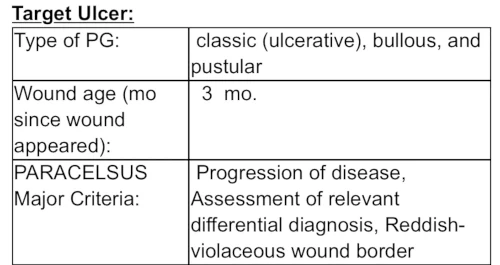
Since getting news of Ryan’s acceptance, the Becker family has set about, within the constraints of Ryan’s pain level and stamina, to do what most couples do in their latter years, writing and checking off what they can of their bucket lists, giving Ryan time to spend with his son, to be grateful for the love and unshakable support of his love and life partner, whether he be given a fair span of years or die too young.
“We’re making the best of whatever the future holds,” Kel whispered.
Despite the pain, Ryan remains focused on being happy today and happier tomorrow, to stay positive.
“The biggest lesson for me has been that hope wanes,” he said. “It’s rough, but you can’t change anything. You can choose to stay positive. To be happy. To choose your outlook.”
They’ve been overwhelmed by they outpouring of love and support they’ve received, and as hard as it is for two people whose lives have been dedicated to giving, they must again ask to be recipients of their community’s love and generosity.
With costs for the upcoming 40 week trial expected to easily exceed $200,000, every GoFundMe donation is cherished. If you’d rather, mail checks payable to Ryan or Mikkel Becker to 9B.News, 6619 Kaniksu St., Rm 19, Bonners Ferry, ID 83805.
Other ways to help include:
- Consider joining the GoFundMe team to help write thank you messages, provide updates, respond to questions, etc. if you would like to join please let Ryan or myself know and we can add you.
- Consider making a regular monthly contribution through the end of the trial.
- Contact local businesses, your church, schools, etc. to see if they would be willing to assist in or sponsor a fundraiser for Ryan.
- Donation of Delta or Hyatt loyalty points to help cut the cost of travel.
- Continue to share Ryan’s journey and the GoFundMe campaign on your social channels and with friends, family, and local community.
- As always and most importantly continue to pray for Ryan and our family as we gear up for this historical fight.
“Thank you again for all of your support, prayers and comforting words,” Kel wrote. “Ryan and our whole family are incredibly grateful for the tremendous outpouring of love you have shown. God Bless!”

Mike,
Once again, you use your gift to bless a family. This devastating medical condition, is rare as the Jackalopes my dad had me try to see in the sagebrush of Southern, Idaho, where I grew up.
Something traumatic like this has affected the whole, extended family. Without giving detail, self-harm and suicide risk, crazy eczema caused by stress, inter-family tension.
We love this community and it has loved us back. Teresa can’t go anywhere without someone checking in on how we’re doing. Our neighbors have been overly generous.
Ryan faces always insurmountable odds. We’re trying hard not to lose hope and ask for a miracle.
Love you all,
Marty